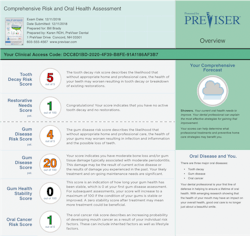The Canadian Centre for Occupational Health and Safety standards look upon risk assessments as a process wherein hazards and risk factors are identified that could potentially cause harm. They help analyze what could happen and the likelihood of it happening. A subsequent determination of appropriate ways to eliminate or control the risk is recommended.1
In dentistry, thinking about risk assessments in this way can be very useful. Risk assessments have evolved to be not only an observation of what is seen in the mouth, but also a care protocol that can aid clinicians in making decisions regarding patients—in other words, they can help clinicians determine how to eliminate or control the risk of certain diseases. Risk assessments are a framework of evidence-based criteria and guidelines that inform patients about optimal care.
One of the greatest advantages for dental patients is that they are seen on a regular basis over long periods of time, which gives clinicians a plethora of knowledge.2 Often patients can be asymptomatic, but through clinical measurements, data gathering, and analysis, clinicians can determine that change is taking place.
This longitudinal record keeping enables dental professionals to monitor clinical conditions over time, rather than simply predict risk at one point in time. Contextual cues, which are often not obvious, such as home care or mental health changes (e.g., someone suffering with depression may lose interest in self-care), can also help professionals assess the likelihood of future disease. This is all accomplished through regular dental appointments, giving clinicians the opportunity to record conditions and get a pulse on the extenuating factors that can affect dental health. Risk assessments are more than just screenings, and have evolved in recent years as dentistry’s role in general health has become greater understood.
Insurance
Some insurance companies are tailoring benefit packages to meet the needs of patients with different risk factors. More periodontal therapy may be available to patients with a high risk factor of periodontal disease, or regular fluoride varnish applications may be available to patients with high caries indices. Risk assessments can also serve to inform patients of consequences if they refuse treatment, and may offer protection legally to the practice.
Screenings versus risk assessments
Traditional screenings, which are designed to identify disease in its preclinical phase, have been the dental profession’s standard of care. Health professionals know that catching disease early can have a direct bearing on curability.3 Screenings determine the absence or presence of disease, its state (active or inactive), and provide a threshold for referrals. Yet, in-depth detail is often missing.
This absence of regular, thorough record keeping can lead to clinicians making less objective assessments of patients' health. Although patients may have a long history with a dental practice, they often see different clinicians. Also, humans are subjective themselves from day to day (sometimes from moment to moment) and may not notice changes when there has been a gradual decline in the patient’s oral health. Science reveals that humans have a bias to overstate benefits and reduce risks.4 Too often, our communication with patients reflects this bias. Also, people’s judgments are influenced by idealogical views. Keeping a regularly updated risk assessment offers valid data about potential problems. It also minimizes human bias.4
The Cochrane Collaboration, a worldwide, not-for-profit organization, suggests that well-documented decision aids “are helpful in reducing effects of biases.”4 This excellent expert volunteer organization catalogs vast numbers of studies from around the world. Its purpose is to help health professionals, policy makers, and patients facilitate evidence-based choices about care. Risk assessments align with the Cochran Collaboration’s mandate.
Academia
Today, risk assessment recording is being taught in dental schools in the United States, Canada, and the United Kingdom. One company, PreViser (previser.com), offers a risk assessment that is widely used in dental schools and is also available to all licensed dental professionals online. It is free of charge. With more than 400 points of measurement in risk assessments, this software program helps in organization and clarity, as well as evaluation and treatment planning (figure 1).
The PreViser site features an assessment for caries, periodontal, and oral cancer risks. There is a range of indices for periodontal disease reflecting the current condition and the cumulative tissue destruction. Clinical attachment loss and pocked depths are useful in the ongoing professional surveillance of moderate or severe periodontal disease. The oral cancer segment of PreViser’s risk assessments offers questions about lifestyle and habits that might pinpoint if a person is at risk of developing oral cancer. There are an estimated 53,000 new cases of oral cancer reported per year in the United States.5 The death rate with oral cancers is high, making early intervention key to longevity.
Other companies and dental offices are creating risk assessments as well. The Wellness Dentistry Network, for example, (wellnessdentistrynetwork.com), brings an even greater holistic view into their assessments by facilitating interprofessional communication. Tests such as salivary diagnostics analyze the microflora of the mouth so that clinicians can help patients rebalance the microbiome. This, along with other tests (A1c, C-reactive protein, etc.), recommended by the expanding network of other health professionals enables a wider determination of the patient’s health.
Wellness Dentistry Network’s risk assessment takes into account the patient’s age, habits (e.g., tobacco, alcohol, diet), cognitive aptitude or ability, hereditary factors, and social involvement. With the recognition of the systemic link between diseases, the Wellness Dentistry Network’s dental risk assessment offers a documented pathway for making referrals to other medical health professionals, such as nutritionists and medical specialties (cardiology, pediatrics, pulmonology, etc.).6 To date, the Wellness Dentistry Network is the only dental organization that is bridging the gap of systemic disease with the medical community, helping dental professionals flag conditions early and enable timely referrals. This holistic view of the body and the systemic link to oral health is, in this writer’s view, the wave of the future and warrants being broadcast and supported.
Although the presence of risk factors may not directly cause a disease, consider that there may well be a correlation. For example, periodontal disease may not be the cause of diabetes, but because of the systemic link of inflammation, it certainly has a correlation.7 The inverse scenario is also true. Looking at oral health as a part of whole-body health is the focus of the Wellness Dentistry Network; not only does it have an extensive network of medical members that it can refer patients to, it also has an impressive hub of online content with information about multiple health conditions, patient education tools, coaching, marketing materials, and telehealth consultations.
Adding to oral findings
Medical professionals today understand the systemic link of oral disease with other diseases of the body. This is why the American Academy of Oral Science (AAOS) promotes evaluations that “include acquisition of information from the medical history, including psychosocial, developmental, and behavioral histories, review of medications, clinical examination findings, measurement of vital signs, review of radiographs and images, laboratory (e.g., complete blood count, hepatic and renal function tests, bleeding indices) and diagnostic tests, and medical consultations, when needed.”8 The AAOS supports checklists covering these points (i.e., a structured sequence so that a holistic diagnostic treatment plan can be created). Based on a clinical evaluation and other influencing factors, dental professionals can assess their patients’ oral health and adjust their risk scores if necessary.
A conversation starter
Assessments can serve as a conversation starter. Patients begin to relate the impact of their lifestyle and/or hereditary factors to oral disease. They begin to understand that their habits have a direct bearing on their oral, physical, and mental health, and hopefully begin to take responsibility. Risk assessments raise the awareness of patients. This engagement is further enhanced at each subsequent appointment, where changes and updates are discussed and recorded. Small changes can have a big impact. Even innocuous changes, such as a change in drinking water source, can impact the amount of fluoride ingested, and for the cavity-prone patient, a reduction of fluoride may lead to a higher incidence of decay.
Prevention
Prevention is the best medicine, and risk assessments offer evidence that can help safeguard health before deterioration happens. Risk assessments are an investment in the patient’s health. They can offer a broader picture of not just the oral health of patients, but also the correlation of oral disease and other systemic diseases. It helps inform the dental professional as well. The clinician’s recommendations and treatment plan are influenced by the data gathered and offer an evidence-based care protocol for decision making. Patients’ needs are better met with this data. Risk assessments can also serve to alert patients about consequences if they refuse treatment, and may offer legal protection for dental practices.
It is this writer’s hope that, with time, the risk assessment will evolve to become a cross-disciplinary tool that can help elevate patients’ most precious investment—their health.
References
1. Risk assessment. Canadian Centre for Occupational Health and Safety website. https://www.ccohs.ca/oshanswers/hsprograms/risk_assessment.html. Accessed May 3, 2019.
2. Brocklehurst PR, Ashley JR, Tickle M. Patient assessment in general dental practice - risk assessment or clinical monitoring? Br Dent J. 2011;210(8):351-354. doi:10.1038/sj.bdj.2011.284.
3. Health screening. Medline Plus website. https://medlineplus.gov/healthscreening.html. Accessed May 18, 2019.
4. Risk asssessment. Wikipedia. https://en.wikipedia.org/wiki/Risk_assessment. Accessed May 10, 2019.
5. Oral cancer facts. The Oral Cancer Foundation website. https://oralcancerfoundation.org/facts/. Accessed May 19, 2019.
6. Erin Howlett, RDH, personal communication, June 19, 2019.
7. Garlough D. Turning the heat down: Solutions for reducing chronic inflammation in our patients’ bodies. RDH magazine website. https://www.rdhmag.com/patient-care/article/16409883/turning-the-heat-down-solutions-for-reducing-chronic-inflammation-in-our-patients-bodies. Published May 14, 2017. Accessed May 11, 2019.
8. Subject: risk assessment. The American Academy of Oral Medicine website. https://www.aaom.com/index.php?option=com_content&view=article&id=152:risk-1. Accessed May 10, 2019.
Dorothy Garlough, MPA, RDH, is a conscious change facilitator, leading strategy sessions and forums to orchestrate conscious change within the dental environment. As a change agent and international speaker and writer, Garlough trains others to broaden their skill sets to include recognition of limiting mental models, creativity, collaborative innovation, and mindfulness. She recognizes that engagement is the outcome when mechanisms are put in place to drive new innovations. The result is lasting change. Contact her at [email protected].
About the Author
Dorothy Garlough, MPA, RDH
Dorothy Garlough, MPA, RDH,is an innovation architect, facilitating strategy sessions and forums to orchestrate change within dentistry. As an international speaker and writer, Garlough trains others to broaden their skill sets to include creativity, collaborative innovation, and forward-thinking. She recognizes that engagement is the outcome when the mechanisms are put in place to drive new innovations. Connect with her at [email protected] or visit engagingteams.com.

